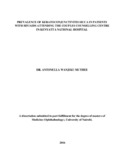| dc.contributor.author | Muthee, Antonella W | |
| dc.date.accessioned | 2016-11-18T07:47:29Z | |
| dc.date.available | 2016-11-18T07:47:29Z | |
| dc.date.issued | 2016 | |
| dc.identifier.uri | http://hdl.handle.net/11295/97539 | |
| dc.description.abstract | Background: HIV and AIDS is one of the greatest public health challenges in Sub-Saharan Africa and especially Kenya. HIV/AIDS can affect the eye and cause sight threatening manifestations, including Keratoconjunctivitis sicca. To the best of our knowledge, this is the first study that has assessed keratoconjunctivitis sicca among HIV+ patients in Kenya.
Objectives: To determine the prevalence of keratoconjunctivitis sicca in participants with HIV/AIDS attending the couples counselling centre at Kenyatta National Hospital.
Study design: A cross sectional descriptive study
Study methodology: The study was carried out among HIV+ and HIV- participants who attend the discordant couples counselling centre at Kenyatta National Hospital. After history was taken, we recorded vision and examined participants under the slit lamp. TBUT and Schirmer’s test were recorded in a questionnaire.
Results: Out of the 544 participants enrolled, 57 (10.5%) were excluded mainly due to pregnancy. We included 487 participants (54% male, 46% female) of mean age. There were 249 (47% male, 53% female) HIV+ of mean age 39.23 ± 8.53 years (range 22-59 years) and 238 (62.2% male, 37.8% female) HIV- participants of mean age 36.77 + 8.25 years (range 21-58 years)
HIV+ participants had a higher prevalence of dry eyes at 30.3% compared to HIV- participants (9.7%) which was statistically significant (p value 0.00, odds ratio 2.8). More HIV+ males had dry eyes (44.4%) compared to the HIV+ females (20.0%). There was no correlation between the CD4 cell count and the severity of the DES among the HIV+ participants ( p value 0.98).
Conclusions: The prevalence of DES among HIV+ patients at KNH is comparable to similar studies in temperate regions. There was no correlation between decrease in tear production and the severity of HIV infection. The effect of HAART on DES could not be determined due to small number of participants not on HAART. | en_US |
| dc.language.iso | en | en_US |
| dc.publisher | University of Nairobi | en_US |
| dc.rights | Attribution-NonCommercial-NoDerivs 3.0 United States | * |
| dc.rights.uri | http://creativecommons.org/licenses/by-nc-nd/3.0/us/ | * |
| dc.title | Prevalence of keratoconjunctivitis sicca in patients with HIV/AIDS attending the couples counselling centre in Kenyatta National Hospital | en_US |
| dc.type | Thesis | en_US |
| dc.description.department | a
Department of Psychiatry, University of Nairobi, ; bDepartment of Mental Health, School of Medicine,
Moi University, Eldoret, Kenya | |



